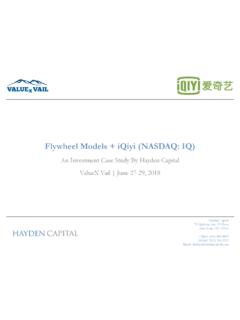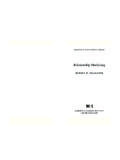Transcription of THE MEASUREMENT OF by Mark L. Sirower, POST …
1 107 JOURNAL OF APPLIED CORPORATE FINANCETHE MEASUREMENT OFPOST-ACQUISITIONPERFORMANCE:TOWARD A value -BASEDBENCHMARKINGMETHODOLOGYby Mark L. Sirower, New York University, andStephen F. O Byrne,Shareholder value Advisors Inc.*107 BANK OF AMERICA JOURNAL OF APPLIED CORPORATE FINANCE time such as R&D or advertising campaigns, acqui-sitions are management decisions whose impact onshareholder value is assessed immediately by mar-kets around the world. For example, in the six-monthbattle for Paramount, Viacom shareholders saw thevalue of their holdings fall by more than half mostof it within a week of Viacom s initial recently, upon announcement of its acquisi-tion of Green Tree, Conseco lost more than $ an amount roughly equal to the premium itpaid to acquire Green Tree. On the other side of thecoin, Procter & Gamble recently gained over $2billion of market value within one week of thecompany s announcement of its acquisition ofTambrands.
2 As these examples serve to illustrate,shareholders of acquiring companies experience awide distribution of wealth changes when acquisi-tions are aim in this paper is to develop and illustratea methodology for forecasting and evaluating post- acquisition operating performance that will be ofinterest to both corporate practitioners and research-ers. Instead of simply comparing post-acquisitionwith pre- acquisition measures of operating perfor-*A version of this article was presented in the New Frontiers in Mergers andAcquisitions Research Symposium, 1997 Academy of Management Meetings,Boston, For a summary of such research, see M. L. Sirower, The Synergy Trap: HowCompanies Lose the acquisition Game (New York: Free Press, 1997).cquisitions remain the most popularmethod of corporate growth of thisgeneration s executive teams, with over$4 trillion worth of such transactions inthe past eight years.
3 Indeed, new records for both thenumber and dollar volume of mergers and acquisi-tions are being set almost daily. But there is littleevidence that such transactions have benefited theshareholders of the acquiring companies, on aver-age. Study after study by financial economists sug-gests that the lion s share of the gains from mergersaccrues to the target firm s shareholders and thatthe acquiring company s shareholders should con-sider themselves lucky just to break even. Although we now have measurements that tellus that most acquisitions fail to add value for theacquiring company s shareholders,1 measuring theactual operating synergies that do result from acqui-sitions is still an unexplored area. It is the discretenature of acquisitions the sudden transformationof two stand-alone companies into a single entity that creates an exciting living laboratory to exploreperformance MEASUREMENT issues.
4 Unlike many othercapital investment decisions that are spread overASo many mergers fail to deliver what they promise that there should be apresumption of failure. The burden of proof should be on showing that anythingreally good is likely to come out of one. Warren Hellman, former head of Lehman Brothers (1994)108 JOURNAL OF APPLIED CORPORATE FINANCE mance, as most academic studies (and many corpo-rate reporting schemes) do, our method uses the pre- acquisition market values of both companies and theacquisition premium to determine the future levelsof annual operating performance that are necessaryto justify the investment. Also in contrast to priorapproaches, our operating performance measuresare expressed in terms of annual expected increasesin EVA, or economic value added. As such, thesemeasures provide a useful economic basis both foracquisition planning and for post- acquisition perfor-mance evaluation and incentive compensation by-product of our benchmarking method-ology is that it enables researchers and practitionersto make a careful assessment of the validity of stockmarket reactions to the announcements of thesemajor discretionary corporate investment studies of the stock market response to acqui-sitions during the 1980s and early 1990s report aroughly 65/35 split between negative and positivereactions to the acquiring companies.
5 And studies ofthe most recent large M&A transactions from 1994-1997 are yielding virtually the same Butmany observers not to mention many corporate strategists have questioned whether these share-holder returns are meaningful predictors of long-runperformance. For example, Michael Porter has ar-gued that short-term market reactions are likely tohave little long-term significance, while assertingthat no self-respecting executive would judge acorporate strategy this way. 3 Given the potentially dramatic effects on thewealth of shareholders, practitioners and research-ers need to find a way to assess the validity of thesemarket value changes to determine whether theinvestors correctly anticipate the long-run effect ofacquistions on shareholder value . We examined themarket s response to 41 large acquisitions between1979 and 1990, and found a strikingly high correla-tion between the acquiring company s short-termstock returns and a present value measure of its firstfive years of post- acquisition operating performancebased on our benchmark.
6 By underscoring theimportance of stock-market reactions to acquisitionannouncements, our results strengthen the case forusing our value - based BRIEF INTRODUCTION TO THEPERFORMANCE MEASUREMENT PROBLEMWhen executive teams play the acquisitiongame, they pay an up-front price that virtually alwaysincludes a substantial premium. To the extent thepremium is justified, it must be based on theacquirer s expectations of making improvements inthe target firm s future performance and exploitingother synergies between the two firms. Only whenperformance gains above stand-alone expectationsare large enough (in present value terms) to recap-ture the premium can an acquisition begin to createvalue for the shareholders of the acquiring research has focused on an appropriatemethod for determining what the actual synergiesare from a given acquisition .
7 But there is one majorchallenge in developing such a method: namely,finding an appropriate benchmark against which tocompare post- acquisition operating performance todetermine the real performance possess unique features that areimportant in framing the benchmarking , acquisitions are a capital investment decisionthat the shareholders of the acquirer can essentiallymake on their own just by buying the shares ofother companies without paying either premiumsor integration expenses. Second, unlike virtually anyother capital investment decision, an acquisitionrequires paying all the money up front, including theacquisition premium, before any improvements canbegin. Finally, paying the acquisition premium cre-ates an additional business problem achievingperformance gains above those already reflected inthe share prices of the two stand-alone cases where no performance improvementsare expected to result from the acquisition , one canforecast the performance of the post- acquisition firmsimply by summing the performance expectationsfor the two stand-alone companies.
8 Acquisitionpremiums are promises of performance gains abovethose already expected by the market. And so, thebase-case benchmarking issues are (1) what is theappropriate measure of performance ; and (2) giventhis measure, how do we assess stand-alone expec-tations at the time of the acquisition ? Once we havedeveloped a method for quantifying stand-alone2. For a review, see M. Sirower and S. Francis, acquisition Strategies andShareholder performance : A Study of Major Transactions of the 1990 s, New YorkUniversity working M. E. Porter, From Competitive Advantage to Corporate Strategy, HarvardBusiness Review (May/June1987), p. OF APPLIED CORPORATE FINANCE expectations, we can easily add the additionalperformance requirements ( , the required syner-gies) created by the payment of an acquisitionpremium. An effective benchmarking methodology ,as we will show, enables management and outsideobservers to monitor the economic results of a givenacquisition strategy.
9 The expected results will beembedded in the stock market reaction to theannouncement of the date, financial researchers have typicallyused either stock returns or accounting returnsindependently to assess the performance gains re-sulting from an acquisition . Most studies of thestock returns of acquiring companies have focusedeither on short-term (anywhere from two days to sixmonths surrounding the announcement) or on long-term (one- to five-year) price movements. Thefindings of such studies (including accounting- based studies) are remarkably consistent in thatvirtually all seem to show negative average returnsto acquirers. Moreover, studies of long-term share-holder returns found declining returns to acquirersover recent years, some studies have attempted toassess the validity of short-term stock market reac-tions to acquisitions by linking those reactions tolong-term stock returns.
10 For example, one studytook 168 large (over $100 million) acquisitions fromthe period 1979 to 1990 and divided them into twoportfolios, those with positive and negative stockmarket reactions, and then tracked the stock marketperformance of these two portfolios over a four-yearperiod following the The negative portfolio remained significantly negative and the positive portfolio remained significantly positivefor the four years following the acquisition . More-over, a similarly designed study of the 100 largestdeals announced during the period 1994 -1997 foundessentially the same These findings suggestthat the market s immediate response to the an-nouncement of an acquisition provides an unbi-ased forecast that is, neither too pessimistic nortoo optimistic, on average of the long-run effect ofthe acquisition on the acquiring firm s the method of these studies is useful fordetermining shareholder wealth effects, it does notprovide a benchmark of stand-alone operating per-formance that can be used for pre- acquisition plan-ning or post- acquisition performance evaluation.



